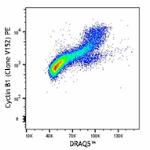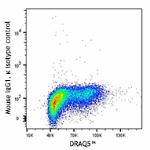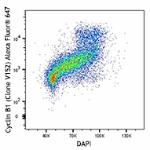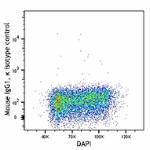- Clone
- V152 (See other available formats)
- Regulatory Status
- RUO
- Other Names
- CCNB1
- Isotype
- Mouse IgG1
- Ave. Rating
- Submit a Review
- Product Citations
- publications

-

Total cell lysates (15 µg total protein) from HEL, HeLa, A549, Jurkat, and NIH/3T3 cells were resolved by 4-20% Bis-Tris gel electrophoresis, transferred to a nitrocellulose membrane, and probed with 1.0 µg/mL (1:500 dilution) of Purified anti-Cyclin B1 Antibody, clone V152, overnight at 4°C. Proteins were visualized by chemiluminescence detection using HRP goat anti-mouse IgG Antibody (Cat. No. 405306) at a 1:3000 dilution. Direct-Blot™ HRP anti-β-GAPDH Antibody (Cat. No. 607904) was used as a loading control at a 1:50000 dilution (lower). Lane M: Molecular Weight marker.
| Cat # | Size | Price | Quantity Check Availability | Save | ||
|---|---|---|---|---|---|---|
| 647901 | 25 µg | £85 | ||||
| 647902 | 100 µg | £182 | ||||
Cyclin B1 belongs to the cyclin family, Cyclin AB subfamily, and predicted molecular weight 48 kD. Cyclin B1 is expressed ubiquitously in all eukaryotes and the level of cyclin B1 was minimal in G, began to rise in S phase, and is primarily cytoplasmic. Cyclin B1 moves into the nucleus just at the start of mitosis and associates with condensed chromosomes and the mitotic spindle. The level of cyclin B1 peaked at the G/M transition. Cyclin B1 is essential for the control of the cell cycle at the G2/M transition. The V152 monoclonal antibody recognizes human and mouse Cyclin B1 and has been shown to be useful for Western blotting and immunohistochemistry (paraffin embedded tissue sections) of human and mouse cyclin B1.
Product DetailsProduct Details
- Verified Reactivity
- Human
- Reported Reactivity
- Mouse
- Antibody Type
- Monoclonal
- Host Species
- Mouse
- Immunogen
- Hamster Cyclin B1
- Formulation
- This antibody is provided in phosphate-buffered solution, pH 7.2, containing 0.09% sodium azide. Final antibody concentration is 0.5 mg/ml.
- Preparation
- The antibody was purified by affinity chromatography.
- Concentration
- 0.5 mg/mL
- Storage & Handling
- The antibody solution should be stored undiluted between 2°C and 8°C.
- Application
-
WB - Quality tested
ICC, IHC - Reported in the literature, not verified in house - Recommended Usage
-
Each lot of this antibody is quality control tested by Western blotting. Western blotting, suggested working dilution(s): Use 2.5 - 5.0 µg antibody per 5 mL antibody dilution buffer for each mini-gel. It is recommended that the reagent be titrated for optimal performance for each application.
- Application Notes
-
Additional reported applications include: immunohistochemistry2 of formalin-fixed paraffin-embedded sections and immunofluorescence1 of methanol fixed cells grown on glass coverslips.
-
Application References
(PubMed link indicates BioLegend citation) - Product Citations
-
- RRID
-
AB_2072274 (BioLegend Cat. No. 647901)
AB_2244210 (BioLegend Cat. No. 647902)
Antigen Details
- Structure
- Belongs to the cyclin family. Cyclin AB subfamily.
- Distribution
-
Ubiquitous expressed in all eukaryotes, predicted molecular weight 48 kD.
- Interaction
- CDC2, Cyclin F, CEB1, PLK, MYT1, PCNA, CDKN1, MAP4
- Bioactivity
- Essential for the control of the cell cycle at the G2/M (mitosis) transition.
- Biology Area
- Cell Biology, Cell Cycle/DNA Replication
- Antigen References
-
1. Morgan DO, et al.1995. Nature 374:131
- Gene ID
- 891 View all products for this Gene ID
- UniProt
- View information about Cyclin B1 on UniProt.org
Related Pages & Pathways
Pages
Related FAQs
Other Formats
View All Cyclin B1 Reagents Request Custom Conjugation| Description | Clone | Applications |
|---|---|---|
| Purified anti-Cyclin B1 | V152 | WB,ICC,IHC |
| PE anti-Cyclin B1 | V152 | ICFC |
| Alexa Fluor® 647 anti-Cyclin B1 | V152 | ICFC |
| Alexa Fluor® 488 anti-Cyclin B1 | V152 | ICFC |
Customers Also Purchased
Compare Data Across All Formats
This data display is provided for general comparisons between formats.
Your actual data may vary due to variations in samples, target cells, instruments and their settings, staining conditions, and other factors.
If you need assistance with selecting the best format contact our expert technical support team.
-
Purified anti-Cyclin B1

Total cell lysates (15 µg total protein) from HEL, HeLa, A54... -
PE anti-Cyclin B1

Jurkat cells were fixed with Fixation Buffer, permeabilized ... 
-
Alexa Fluor® 647 anti-Cyclin B1

Jurkat cells were fixed with Fixation Buffer, permeabilized ... 
-
Alexa Fluor® 488 anti-Cyclin B1

Jurkat cells were fixed with Fixation Buffer, permeabilized ... 
 Login / Register
Login / Register 











Follow Us